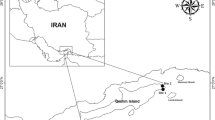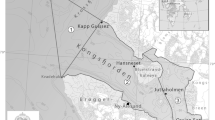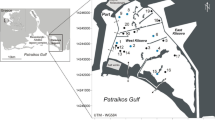Abstract
In this study, we combined remote sensing data and in situ observations to explore the potential habitats of macroalgae at Libukang Island, Indonesia. High-resolution satellite images from the GeoEye-1 were used to estimate and to map the geomorphological structures together with macroalgal species in the study area. Seasonal variations of percentage cover and biomass of macroalgae associated with substrates were investigated in May and November 2014, and June 2015, using quadrats as sampling unit. A total of nine common genera were found in the study area with three dominant genera: Sargassum, Padina, and Turbinaria. Most of macroalgae was observed in the eastern part of the Island, on several substrate types and particular oceanographic conditions (wave and current). Mean biomasses of Sargassum and Padina were high in May (1189.6 ± 455 and 166.7 ± 15.4 g DW.m−2, respectively), while the biomass of Turbinaria was high in November (3245 ± 599.8 g DW.m−2). The map accuracy of image classification for all typology substrates was 74.19%. Overall, approximately 62.3% of the total study area can be considered as potential for natural macroalgae habitats. Spectral response characteristic of shallow water substrates at study area based on GeoEye-1 is also presented. The results of this study exhibit a potential utilization of natural macroalgae in the study area, and provide information for a possible diversification of the use of macroalgae in Indonesia. The method could be useful for habitat management and future biomonitoring in the study area or other similar areas in Indonesia.




Similar content being viewed by others
References
Aldrian E, Susanto R (2003) Identification of three dominant rainfall regions within Indonesia and their relationship to sea surface temperature. Int J Climatol 23:1435–1452
Andréfouët S, Kramer P, Torres-Pulliza D, Joyce KE, Hochberg EJ, Garza-Pérez R, Mumby PJ, Riegl B, Yamano H, White WH, Zubia M, Brock JC, Phinn SR, Naseer A, Hatcher BG, Muller-Karger FE (2003) Multi-site evaluation of IKONOS data for classification of tropical coral reef environments. Remote Sens Environ 88:128–143
Andréfouët S, Zubia M, Payri C (2004) Mapping and biomass estimation of the invasive brown algae Turbinaria ornata (Turner) J. Agardh and Sargassum mangarevense (Grunow) Setchell on heterogeneous Tahitian coral reefs using 4-meter resolution IKONOS satellite data. Coral Reefs 23:26–38
Ateweberhan M, Bruggemann JH, Breeman AM (2009) Seasonal changes in size structure of Sargassum and Turbinaria populations (Phaeophyceae) on tropical reef flats in the southern Red Sea. J Phycol 45:69–80
Atmadja WS, Prud’homme van Reine WF (2012) Checklist of the seaweed species biodiversity of Indonesia with their distribution and classification: Rhodophyceae. [Ceklis keanekaragaman jenis rumput laut di Indonesia dengan sebaran dan klasifikasinya merah (Rhodophyceae)]. Jakarta: coral reef information and training centre. Coral Reef Rehabilitation and Management Programme. Indonesian Institute of Sciences (LIPI), DKI Jakarta. (2), i–vi, pp. 1–72
Bellwood DR, Hughes TP, Hoey AS (2006) Sleeping functional group drives coral-reef recovery. Curr Biol 16:2434–2439
Bourgougnon N, Stiger-Pouvreau V (2011) Chemodiversity and bioactivity within red and brown macroalgae along the French coasts, metropole and overseas departments and territories. In: Kim S-K (ed) Handbook of marine macroalgae. Wiley, Hoboken, pp 58–105
Casal G, Kutser T, Domínguez-Gómez JA, Sánchez-Carnero N, Freire J (2011) Mapping benthic macroalgal communities in the coastal zone using CHRIS-PROBA mode 2 images. Estuar Coast Shelf Sci 94:281–290
Chopin T, Neish I (2014) The 21st International Seaweed Symposium: seaweed science for sustainable prosperity. J Appl Phycol 26:695–698
Cohen J (1960) A coefficient of agreement for nominal scales. Educ Psychol Meas 20:37–46
Congalton R (1991) A review of assessing the accuracy of classifications of remotely sensed data. Remote Sens Environ 37:35–46
Deslandes E, Pondaven P, Auperin T, Roussakis C, Guezennec J, Stiger V, Payri C (2000) Preliminary study of the in vitro antiproliferative effect of a hydroethanolic extract from the subtropical seaweed Turbinaria ornata (Turner) J. Agardh on a human non-small-cell bronchopulmonary carcimona line (NSCLC-N6). J Appl Phycol 12:257–262
Diaz-Pulido G, McCook LJ (2003) Relative roles of herbivory and nutrients in the recruitment of coral reef seaweeds. Ecology 84:2026–2033
Fyfe SK (2003) Spatial and temporal variation in spectral reflectance: are seagrass species spectrally distinct? Limnol Oceanogr 48:464–479
Gattuso JP, Payri CE, Pichon M, Delasalle B, Frankignoulle M (1997) Primary production, calcification, and air-sea CO2 fluxes of a macroalgal-dominated coral reef community (Moorea, French Polynesia). J Phycol 33:729–738
Golléty C, Migné A, Davoult D (2008) Benthic metabolism on a sheltered rocky shore: role of the canopy in the carbon budget. J Phycol 44:1146–1153
Guiry MD, Guiry GM (2016) Algae Base. World-wide electronic publication. National University of Ireland, Galway http://www.algaebase.org; searched on 28 October 2016
Hadi F, Zakaria IJ, Syam Z (2016) Diversity of macroalagae in Kasiak Gadang Island Nirwana Beach, Padang-West Sumatera, Indonesia. J Trop Life Sci 6:97–100
Hau LN, Son TPH, Mai VX (2009) Application of remote sensing techniques to detect the distribution of Sargassum meadows in coastal waters of Khanh Hoa Province. Proceedings of the National Conference on Marine Biology and Sustainable Development (Hanoi, Vietnam): pp 574–580
Hay ME (1997) The ecology and evolution of seaweed-herbivore interactions on coral reefs. Coral Reefs 16:S67–S76
Heege T, Bergin M, Hartmann K, Schenk K (2016) Chapter 18 Satellite services for coastal applications. In: Wright J (Ed) Ocean Solutions, Earth Solutions 2nd Edn: 357–368
Hosmer D W, Lemeshow S (2000) Applied logistic regression 2nd edn. Wiley, New York. pp 47–56
Hoang TC, Cole AJ, Fotedar RK, O'Leary MJ, Lomas MW, Shovonlal R (2016) Seasonal changes in water quality and Sargassum biomass in southwest Australia. Mar Ecol Prog Ser 551:63–79
Hossain MS, Bujang JS, Zakaria MH, Hashim M (2016) Marine and human habitat mapping for the coral triangle initiative region of Sabah using Landsat and Google Earth imagery. Mar Policy 72:176–191
Hudson WD, Ramm CW (1987) Correct formation of the kappa coefficient of agreement. Photogramm Eng Remote Sens 53:421–422
Hughes TP, Rodrigues MJ, Bellwood DR, Ceccarelli D, Hoegh-Guldberg O, McCook L, Moltschaniwskyj N, Pratchett MS, Steneck RS, Willis B (2007) Phase shifts, herbivory, and the resilience of coral reefs to climate change. Curr Biol 17:360–365
Iken K (2012) Grazers on benthic seaweeds. In: Wiencke C, Bischof K (eds) Seaweed biology. Springer, Berlin, pp 157–175
Kendall MS, Kruer CR, Buja KR, Christensen JD, Finkbeiner M, Warner RA, Monaco ME (2001) Methods used to map the benthic habitats of Puerto Rico and the U.S. Virgin Islands. NOAA Technical Memorandum NOS NCCOS CCMA, Silver Spring, p 152
Kerr JT, Ostrovsky M (2003) From space to species: ecological applications for remote sensing. Trends Ecol Evol 18:299–305
Kutser T, Vahtmäe E, Martin G (2006) Assessing suitability of multispectral satellites for mapping benthic macroalgal cover in turbid coastal waters by means of model simulations. Estuar Coast Shelf Sci 67:521–529
Le Lann K, Kraffe E, Kervarec N, Cérantola S, Payri CE, Stiger-Pouvreau V (2014) Isolation of turbinaric acid as a chemomarker of Turbinaria conoides (J. Agardh) Kützing from South Pacific islands. J Phycol 50:1048–1057
Le Lann K, Ferret C, Van Mee E, Spagnol C, Lhuillery M, Stiger-Pouvreau V (2012) Total phenolic, size-fractionated phenolics and fucoxanthin content of tropical Sargassaceae (Fucales, Phaeophyceae) from the South Pacific Ocean: spatial and specific variability. Phycol Res 60:37–50
Le Lann K, Kervarec N, Payri CE, Deslandes E, Stiger-Pouvreau V (2008) Discrimination of allied species within the genus Turbinaria (Fucales, Phaeophyceae) using HRMAS NMR spectroscopy. Talanta 74:1079–1083
Lyzenga DR (1978) Passive remote sensing techniques for mapping water depth and bottom features. Appl Opt 17:379–338
Lyzenga DR (1981) Remote sensing of bottom reflectance and water attenuation parameters in shallow water using aircraft and Landsat data. Int J Remote Sens 1:71–82
Lobban CS, Harrison PJ (1997) Seaweed ecology and physiology. Cambridge University Press, Cambridge
Mattio L, Payri CE (2011) 190 years of Sargassum taxonomy, facing the advent of DNA phylogenies. Bot Rev 77:31–71
Mattio L, Dirberg G, Payri CE, Andréfouët S (2008a) Diversity, biomass and distribution pattern of Sargassum beds in the south west lagoon of New Caledonia (South Pacific). J Appl Phycol 20:811–823
Mattio L, Payri CE, Stiger-Pouvreau V (2008b) Taxonomic revision of Sargassum (Fucales, Phaeophyceae) from French Polynesia based on morphological and molecular analyses. J Phycol 44:1541–1555
Mattio L, Payri CE, Verlaque M (2009) Taxonomic revision and geographic distribution of subgenus Sargassum (Fucales, Phaeophyceae) in the western and central Pacific islands based on morphological and molecular analyses. J Phycol 45:1213–1227
McCook LJ (1999) Macroalgae, nutrients and phase shifts on coral reefs: scientific issues and management consequences for the Great Barrier reef. Coral Reefs 18:357–367
McClanahan TR, Sala E, Stickels PA, Cokos BA, Baker AC, Starger CJ, Jones SHI (2003) Interaction between nutrients and herbivory in controlling algal communities and coral condition on Glover’s Reef, Belize. Mar Ecol Prog Ser 261:135–147
Migné A, Delebecq G, Davoult D, Spilmont N, Menu D, Gevaert F (2015) Photosynthetic activity and productivity of intertidal macroalgae: in situ measurements, from thallus to community scale. Aquat Bot 123:6–12
Morrison GL, Sudjito (1992) Solar radiation data for Indonesia. Sol Energy 49:65–76
Mumby PJ, Edward AJ, Green EP, Anderson CW, Ellis AC, Clarck CD (1997) A visual assessment technique for estimating seagrass standing crop. Aquat Conserv 7:239–251
Mumby PJ, Clark CD, Green EP, Edwards AJ (1998) Benefits of water column correction and contextual editing for mapping coral reefs. Int J Remote Sens 19:203–210
Nagendra H (2001) Using remote sensing to assess biodiversity. Int J Remote Sens 22:2377–2400
Noiraksar T, Shuhei S, Sophany P, Komatsu T (2014) Mapping Sargassum beds off the coast of Chon Buri Province, Thailand, using ALOS AVNIR-2 satellite imagery. Bot Mar 57:367–377
Phillips N (1995) Biogeography of Sargassum (Phaeophyta) in the Pacific basin. In: Abbott IA (ed) Taxononomy of economic seaweeds, vol Vol 5. California College Seagran Program, USA, pp 107–144
Prathep A (2005) Spatial and temporal variations in diversity and percentage cover of macroalgae at Sirinart Marine National Park, Phuket Province, Thailand. Sci Asia 31:225–233
Prathep A, Wichachucherd B, Thongroy P (2007) Spatial and temporal variation in density and thallus morphology of Turbinaria ornata in Thailand. Aquat Bot 86:132–138
Rohfritsch A, Payri C, Stiger V, Bonhomme F (2007) Molecular and morphological relationships between two closely related species, Turbinaria ornata and T. conoides (Sargassaceae, Phaeophyceae). Biochem Syst Ecol 35:91–98
Rogers C, Garrison G, Grober R, Hillis ZM, Franke MA (1994) Coral reef monitoring manual for the Caribbean and Western Atlantic, St. John: National Park Service, Virgin Islands National Park: p 120
Sagawa T, Mikami A, Aoki MN, Komatsu T (2012a) Mapping seaweed forests with Ikonos image based on bottom surface reflectance. In Robert JF, Naoto E, Delu P, Toshiro S (eds.) Proceedings of SPIE Remote Sensing of the Marine Environment II (Kyoto, Japan) 85250:Q1–Q7
Sagawa T, Watanabe T, Watanuki A, Koike T, Kamimura H, Komats T (2012b) Can ALOS-3/HISUI detect seaweed beds more precisely than ALOS/AVNIR-2? In Robert JF, Naoto E, Delu P, Toshiro S (eds.) Proceedings of SPIE Remote Sensing of the Marine Environment II (Kyoto, Japan) 85250: Y1–Y9
Schiel DR, Steinbeck JR, Foster MS (2004) Ten years of induced ocean warming causes comprehensive changes in marine benthic communities. Ecology 85:1833–18339
Silberfeld T, Bittner L, Fernández-García C, Cruaud C, Rousseau F, Reviers B, Leliaert F, Payri CE, De Clerck O (2013) Species diversity, phylogeny and large scale biogeographic patterns of the genus Padina (Phaeophyceae, Dictyotales). J Phycol 49:130–142
Siddiqui MD, Zaidi A (2015) Worldview-2 and Landsat 8 satellite data for seaweed mapping along Karachi Coast running title: seaweed mapping along Karachi Coast using satellite data. Pak J Eng Technol Sci 5:134–151
Stengel DB, Connan S, Popper ZA (2011) Algal chemodiversity and bioactivity: sources of natural variability and implications for commercial application. Biotechnol Adv 29:483–501
Stiger V, Payri CE (1999a) Spatial and seasonal variations in the biological characteristics of two invasive brown algae, Turbinaria ornata (Turner) J. Agardh and Sargassum mangarevense (Grunow) Setchell (Sargassaceae, Fucales) spreading on the reefs of Tahiti (French Polynesia). Bot Mar 42:295–306
Stiger V, Payri CE (1999b) Spatial and temporal patterns of settlement of the brown macroalgae, Turbinaria ornata and Sargassum mangarevense in a coral reef on Tahiti. Mar Ecol Prog Ser 191:91–100
Stiger V, Deslandes E, Payri CE (2004) Phenolic contents of two brown algae, Turbinaria ornata and Sargassum mangarevense on Tahiti (French Polynesia): interspecific, ontogenic and spatio-temporal variations. Bot Mar 47:402–409
Stiger V, Payri CE (2005) Natural settlement of a young population of Turbinaria ornata and phenological comparisons with older populations. Aquat Bot 81:225–243
Stiger-Pouvreau V, Bourgougnon N, Deslandes E (2015) Carbohydrates from seaweeds. In: Fleurence J, Levine I (eds) Seaweed in health and disease prevention. Elsevier, Amsterdam, pp 223–274
Thongroy P, Liao LM, Prathep A (2007) Diversity, abundance and distribution of macroalgae at Sirinart Marine National Park, Phuket Province, Thailand. Bot Mar 50:88–96
Utojo MA, Pantjara B, Marsambuana P, Hasnawi (2007) The suitable waters environment condition of Malasoro Bay for Eucheuma sp. seaweed culture development location. J Ris Akua 2:243–255
Vahtmäe E, Kutser T (2007) Mapping bottom type and water depth in shallow coastal waters with satellite remote sensing. J Coast Res 50:185–189
Veron JEN, Devantier LM, Turak E, Green AL, Kininmonth S, Stafford-Smith M, Peterson N (2009) Delineating the coral triangle. Galaxea 11:91–100
Walker BK, Foster G (2009) In: Rohmann S (ed) Accuracy assessment and monitoring for NOAA Florida keys mapping AA ROI-1 (Hawk Channel Near American Shoal). Office of National Marine Sanctuaries NOS/NOAA, Silver Spring, pp 1–32 http://nsuworks.nova.edu/occ_facreports/33
Wismer S, Hoey AS, Bellwood DR (2009) Cross-shelf benthic community structure on the Great Barrier Reef: relationships between macroalgal cover and herbivore biomass. Mar Ecol Prog Ser 376:45–54
Wouthuyzen S, Sekar M, Komatsu T (2009) Stock assessment of brown seaweeds (Phaeophyceae) along the Bitung-Bentena Coast, North Sulawesi Province, Indonesia for alginate product using satellite remote sensing. Procedia Environ Sci 33:553–561
Xie Y, Sha Z, Yu M (2008) Remote sensing imagery in vegetation mapping: a review. J Plant Ecol 1:9–23
Zitello AG, Bauer LJ, Battista TA, Mueller PW, Kendall MS, Monaco ME (2009) Benthic habitats of St. John, U.S. Virgin Islands. NOAA Technical Memorandum NOS NCCOS 96, Silver Spring, p 53
Zubia M, Payri C, Deslandes E (2008) Alginate, mannitol, phenolic compounds and biological activities of two range-extending brown algae, Sargassum mangarevense and Turbinaria ornata (Phaeophyta: Fucales), from Tahiti (French Polynesia). J Appl Phycol 20:1033–1043
Zubia M, Andrefouet S, Payri C (2015) Distribution and biomass evaluation of drifting brown algae from Moorea lagoon (French Polynesia) for eco-friendly agricultural use. J Appl Phycol 27:1277
Acknowledgements
Thanks to INDESO Project for the financial support of this research of the first author. We thank LEMAR (Marine Environmental Sciences Laboratory) for their laboratories welcoming and support during the research process at the University of Brest, France. Thanks to seaweeds farmer in Libukang Island and all students (Friska, Dede, and Nopi) for their helps during field observation.
Author information
Authors and Affiliations
Corresponding author
Rights and permissions
About this article
Cite this article
Setyawidati, N., Kaimuddin, A.H., Wati, I.P. et al. Percentage cover, biomass, distribution, and potential habitat mapping of natural macroalgae, based on high-resolution satellite data and in situ monitoring, at Libukang Island, Malasoro Bay, Indonesia. J Appl Phycol 30, 159–171 (2018). https://doi.org/10.1007/s10811-017-1208-1
Received:
Revised:
Accepted:
Published:
Issue Date:
DOI: https://doi.org/10.1007/s10811-017-1208-1




